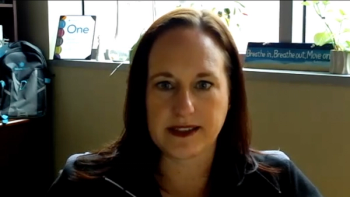
New Oncology Care Model Unfolds From CMS
During the NCCN Annual Conference, Ron Kline, MD, FAAP, from CMS’s Innovation Center, discussed the Center’s pilot Oncology Care Model.
The Center for Medicare and Medicaid Innovation (the Innovation Center) was established within the Centers for Medicare & Medicaid Services (CMS) to test innovative payment techniques and service delivery models.
In a keynote address during the National Comprehensive Cancer Network (NCCN) Annual Conference, held March 22–24 in Orlando, Florida, Ron Kline, MD, FAAP, medical officer in the patient care models group at the Innovation Center, discussed the pilot Oncology Care Model (OCM), which he directs.
He pointed to the growing burden of cancer care, highlighting the economic burden, and said that a significant proportion of patients are over the age of 65 years and are Medicare beneficiaries. According to the National Institutes of Health, medical expenditures for cancer in the year 2020 are projected to reach at least $158 billion, a 27% increase from 2010.
“Care is fragmented and it’s not always high value,” said Kline, who also remains a practicing pediatric oncologist.
The Innovation Center is working in consultation with clinicians to increase both the number and variety of models that are available, with the goal of improving the quality of care at the same or lower cost. The OCM is a 5-year model that was initiated in 2016 and will end in 2021, and the hope is that it will promote both high quality and high value care.
Kline briefly outlined the main points of the program. It is episode-based, meaning that the payment model targets chemotherapy and related care during a 6-month period that begins with receipt of chemotherapy treatment.
The OCM also puts an emphasis on practice transformation. Physician practices are required to implement “practice redesign activities” to improve the quality of care that they deliver to patients. There are also multipayer models that include Medicare fee-for-service and other payers working in tandem to leverage the opportunity to transform care for oncology patients across a population of practices.
Physician practices that want to participate must adhere to certain stipulations, such as providing 24/7 access to a clinician that has access to the patient’s medical records, using electronic health records, documentation and use of the Institute of Medicine’s Care Management Plan, and administering treatment that is consistent with clinical guidelines.
There have been challenges in implementing the OCM, and a lot of lessons learned, he pointed out. “We have had issues estimating out-of-pocket costs, and we are trying to make that better,” said Kline. He also noted that there have been technology issues which “we are fixing.”
They have also worked on methodology, such as differentiating between high- and low-risk cancers, and “we have learned the difference between bladder and prostate cancer-that was brought up to us and we fixed it,” Kline noted. “We learned about Z51 as a [billable/specific] code that people use and we fixed that.”
Kline emphasized that he is listening to physicians, and that they are learning as the program unfolds. “We are trying to improve care for cancer patients,” he said.
Despite the challenges of implementing OCM, he explained that the preliminary results, which he was presenting from the first reporting period, show that progress has been made. To date, 25% of Medicare fee-for-service chemotherapy-related cancer care, in a total of 187 practices for 150,000 unique beneficiaries each year (representing approximately 200,000 episodes of care), is now being administered under OCM. There are also 14 commercial payers currently participating in the model.
Another part of the OCM is performance-based payment, which pays for enhanced services for patients that are combined with the usual Medicare payments. There is also the potential for a retrospective performance-based payment that is based on quality and savings. Kline explained that these payments are based on the ability of a practice to achieve quality measures and on reductions in Medicare expenditures below a target price. The payments are given as a semiannual bonus.
Kline noted that “one of the nice things we hear from practices is that they say ‘we are providing the care we always wanted to provide it, we are not doing fee-for-service. We’re taking care of our patients and that’s where we want to be.’”
“The practices tell us that they are improving care coordination, symptom management, palliative care, and end of life care,” he added. They are also “addressing financial toxicity and improving communication with patients and other providers.”
Newsletter
Stay up to date on recent advances in the multidisciplinary approach to cancer.
















































































